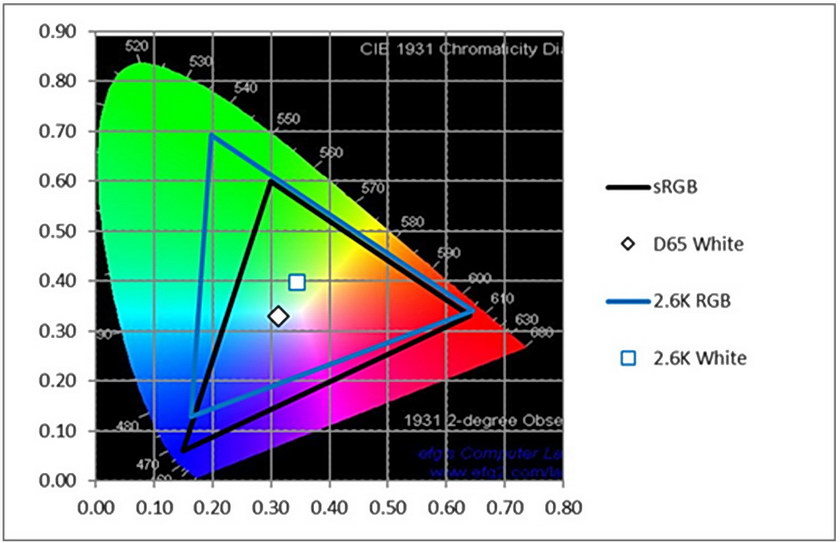On June 30th, Kopin Corporation formally announced its 2.6K x 2.6K (2560 x 2560) resolution chip that had previously been discussed at CES 2020. While Display Daily has republished the press release, I wanted some more details so I got in touch with Dr. Hong Choi, Kopin’s Chief Technology Officer since September 2000, to see if any additional information was available.

 An Airbus A380 as shown on the Kopin’s 2.6K x 2.6K (2560 x 2560) OLED Display on Chip (DOC) device. (Credit: Kopin)
An Airbus A380 as shown on the Kopin’s 2.6K x 2.6K (2560 x 2560) OLED Display on Chip (DOC) device. (Credit: Kopin)
The device is 1.3” (33mm) in diagonal and has a resolution of 2.6K x RGB x 2.6K (2560 x RGB x 2560). When it enters production, it will be a part of Kopin’s Lightning series of displays. The current version of the device is said to achieve 1000 cd/m² (nits) with a contrast of 10:000:1 right now. Kopin is working with its OLED foundry partner, Lakeside Optoelectronic Technology Co., Ltd., established in April of 2017, to further improve the color fidelity and brightness to > 2000 nits through optimization of OLED deposition conditions. According to Kopin,
“By incorporating a structure to enhance the output coupling efficiency, the brightness of the OLED microdisplay could be increased to > 5000 nits within a couple of years.”
According to Dr. Choi, the pixel pitch is 9.15?m and the RGB subpixel size is 3.05?m x 9.15?m. The device uses a “color by white” technology and the OLED materials are not patterned horizontally.
Kopin uses a Duo-Stack approach in its 2.6K x 2.6K device (Credit: Kopin)
This is not just another OLED chip: the device uses two important and innovative technologies. First, it uses a dual-layer OLED design that Kopin calls Duo-Stack. This is said to provide a number of advantages, including:
- Two OLED structure stacked in series connection
- Duo-Stack provides more flexibility in OLED design, allowing improved colorimetry.
- Electron/hole pairs generate photons twice
- Much higher efficiency than a single stack
- Efficiency > 6 candela/ampere
- Higher brightness (Up to 4x) at the same current
- Longer lifetime at high brightness
- Kopin ColorMax backplane with proprietary anode structure enables excellent duo-stack OLED displays with high color fidelity.
 Color Gamut of the Kopin 2.6K x 2.6K Duo-Stack OLED device (Credit: Kopin)
Color Gamut of the Kopin 2.6K x 2.6K Duo-Stack OLED device (Credit: Kopin)
According to Kopin, previous designs with the two-stack OLED structure introduced color mixing among subpixels, resulting in unacceptable color performance. Kopin’s patent-pending innovation incorporates a specially configured anode structure in the Si backplane to suppress this color mixing. According to Kopin, this results in a color gamut that is > 115% sRGB. This is somewhat misleading, as shown it the color gamut of the device. The green primary of the device is much “greener” than called for by sRGB and the blue primary is not as blue. While the area may be greater than the sRGB area, people use the sRGB standard because they want to get accurate color reproduction. Even with optimized color processing, this device could not correctly reproduce sRGB blues.
Besides the Duo-Stack OLED system, there is a second innovation in the 2.6K x 2.6K device: the silicon backplane. This backplane is more than just an active matrix to drive the OLED sub-pixels. It includes additional features such as:
- Patent-pending design of the electrodes to limit color contamination between sub-pixels
- Backplane integrates high-speed D-PHY/C-PHY MIPI interface
- Backplane integrates Display Stream compression, allowing high-speed data loading with 3:1 compression
- 10 Bit drive of the OLED Duo-Stack
- Integrated memory
Because of the complexity of the backplane, this device does not need supporting external drive chips and Kopin describes it as a “Display on Chip” (DoC) system and have given the backplane design the name “ColorMax.” In addition, because of the high contrast ratio, the 10-bit drive and the high brightness, Kopin says the DoC “enables the much-desired studio-quality, high dynamic range (HDR) capable VR experience.”
According to Dr. Boryeu Tsaur, General Manager of Kopin’s OLED Display business unit,
“We plan to enhance our backplane design further to reach 120-Hz frame rate operation with global shutter while reducing power consumption even further in our second generation 2.6K x 2.6K DoC. We expect to have the second generation 2.6K x 2.6K DoC ready by the end of this year and commercially available to select partners in 2021.”
 Panasonic HMD shown at CES 2020 with a Kopin OLED display. (Credit: Panasonic)
Panasonic HMD shown at CES 2020 with a Kopin OLED display. (Credit: Panasonic)
At CES 2020, Panasonic showed a VR HMD that used a Kopin OLED microdisplay. Before CES, Panasonic said this HMD would be “The world’s first HDR capable VR eyeglasses as of this announcement on January 6, 2020.” According to Dr. Choi, the microdisplay used in Panasonic’s HMD at CES was one of Kopin’s 0.99” diagonal 2K x 2K Lightning-series microdisplays, masked down to a 16:9 format. He added that Panasonic and Kopin were working on a version of this HMD that will use the new 2.6K x 2.6K Duo-Stack DoC with the ColorMax backplane. The optics of the HMD system were co-developed by Panasonic, Kopin and 3M. The new 1.3” diagonal chip is likely to need different optics than the system shown at CES, especially if Panasonic wants to use the full 2.6K x 2.6K resolution of the new chip instead of masking it down to 16:9.
At CES, Panasonic described this HMD as a “reference product,” indicating the product displayed is not intended to be introduced as-is into production. Panasonic did not (publicly) give any roadmap for the development of this technology. Not surprisingly, Dr. Choi declined to comment on when he though Panasonic would introduce the system to the market. In the Kopin press release, Dr. John Fan, president of Kopin, indicated that any product from Panasonic would use the second generation of the ColorMax backplane, planned to be available in 2021.
Almost casually, Kopin says in the press release that a VR HMD “also needs a thin, compact Pancake optics to pair with the wearable monitor to provide studio-like immersive color video images.” Kopin’s recently issued HMD optics patent, which may not be the design used in the Panasonic HMD, will be discussed in tomorrow’s Display Daily as an example of the sort of design needed in a VR HMD. – Matthew Brennesholtz

